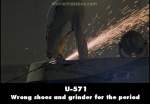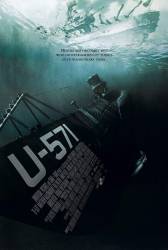Factual error: At the beginning of the film the German commander is shown directing an attack using the periscope in the control room. German U-boats had two periscopes: a 'sky' scope (the one in the control room) used exclusively for searching the area directly above the boat prior to surfacing, and the 'attack' periscope located in the conning tower (turm). There'd be no sense in the commander using the sky scope - the attack scope had an integrated firing switch, much more stable view, smaller outline over water and better magnification. (00:03:00)
Factual error: At the beginning of the film the depth charge attack is shown rupturing a diesel fuel line in the engine room, which showers the fuel DOWN on the crew stationed there. In fact the fuel lines ran UNDER the deck plates and so a broken line could not shower fuel in that manner. (00:05:55)
Factual error: Depth charges explode at a distance of some 10 meters from the boat without any fatal effect. In reality fatal (i.e. destroying) distance was some 50 meters. (00:06:00)
Suggested correction: The second sentence is in error. Hull-rupture maximum distance is approximately FIVE meters. K-gun DISPERSION range was selectable from the attacking DD or DE: (1) Mk-6 at 50, 75, and 120 yards, (2) Mk-9 at 60, 90, and 150 yards.Citation:http://uboat.net/allies/technical/depth_charges.htm states "The pressure hull of the U-boat was strong enough to withstand anything but a charge exploding 10 or 20 feet from its hull.", and http://www.math.iitb.ac.in/~manishk/msc_project/OR-Notes-Mirror/OR-Notes/mscmga.ms.ic.ac.uk/jeb/or/intro.html states "As mentioned above the standard 250lb depth charge was believed to have a lethal radius of only 5-6 metres."
I have seen German sources which suggest any depth charge going off closer than 100 meters would be instantly deadly. I don't know where those sites you cite get their info from, but descriptions of battles from the era of from a submariner's perspective make it look extremely unlikely that bombs of the stats which you describe would have been an effective weapon at all.
100 metres is 330ft. If depth charges were that effective, the Battle of the Atlantic would have been won in days. Escort ships used to drop ten charges in a pattern to sandwich the sub when they exploded.
Factual error: At the beginning of the film the diesel fuel in the German U-boat is shown being ignited by a spark and bursting into flames during the depth charge attack as if it were gasoline. In reality diesel fuel is quite hard to ignite when not compressed and does not burn quite so readily as shown in the film. (00:06:05)
Factual error: At the beginning of the movie, the German commander wants to send an emergency message with coordinates to the BdU, the German Submarine Command, to send help. The scene is subtitled in English with "To Berlin: Location 85-32." However, the command post at the time was based in Lorient, France and not in Berlin. (00:08:05)
Suggested correction: He didn't send the message to the BdU, his message was send to the OKM (OberKommando der Marine), which had its headquarters in Berlin, because it involved the enigma code (although the movie is only loosely based on historic events). These kinds of messages were always send to Berlin. This is because the OKM answered to the OKH, which in turn answered to Hitler who was of course also in Berlin. This is their concern, not that of the BdU.
Of course he does, the commander literally says to the radioman "Ruf an BdU absetzen: Position AL 85-32. Alle Maschinen ausgefallen, manövrierunfähig, erwarten Hilfe" or "Send transmission to BdU: Position AL 85-32. All engines out of service, unable to manoeuvre, we expect help." This was correct procedure, proper chain of command would always be to contact the BdU, not the OKM. Also the integrity of the enigma was probably not a concern at that time, the crew would have ample time to destroy all sensitive materials if they were in danger. The German commander's main concern was to get his sub back up and running.
Right, I couldn't understand that part before. But you are right.
Factual error: The yard set has a red and white stop sign. Stop signs during WWII were yellow with black letters. (00:12:30)

Factual error: In the ship yard after the party, one of the navy crew is working on a sub and he is using a yellow plastic handled grinder. All tools in this era were metal handled. He's also wearing tennis shoes. (00:13:15)
Factual error: When the marine commando shows the sailor his "luggage" (the boxes of explosives) to be loaded onto the submarine, some of the boxes have orange Explosive B placards. Those are Dept. of Transportation placards. The D.O.T. didn't exist until 1966 and the placards were not used until later than that. (00:19:55)
Factual error: It takes a whole of two minutes from the discovery of the boarding party and the cry "Alarm" till the first Americans even enter the command central of U-571, and another almost 90 seconds till they secure the radio room. German subs were under strict orders to destroy all secret material the instant they had reason to believe a boarding was probable. To that end, all code books were printed in water-soluble inks on water-soluble paper, and even the electrical connections inside the rotors of the enigma machine were seawater-soluble. (Admittedly the latter was more with the idea of enemies salvaging sunk boats in mind, and I have no information on how fast that decay would have happened) All it would have taken is to lift up one of the floor plates and drop the stuff into the bilge below. And yes, since German subs of the era didn't have answering machines, the radio room would be manned around the clock. For that reason, boarding actions of that sort had to be above all lightning-fast. Dramatic as the fight scene is, in reality it would have ensured that the boarding party came away empty-handed. (00:38:30 - 00:41:45)
Factual error: When the American crew storms the U-571 and reaches the aft compartment, where the last Germans are gathered, we can see a row of bunks on each side of the chamber. The VIIC type has no crew acommodation in this place; the last compartment houses just the electric motors and some pumps and auxiliary machinery, as well as the breach of the aft torpedo tube. (00:43:30)
Factual error: When the Americans are initially scrambling to figure out how the German submarine works, Rabbit opens a torpedo breech door, closes it and reports to Tyler "We have four fish, tubes are flooded." They are obviously not all flooded, otherwise Rabbit would just have flooded the compartment by opening the breech. (00:53:12)
Factual error: When Rabbit first checks the German sub's torpedo tubes, we catch a glimpse of the torpedo loaded in the tube, its propulsion screws visible. It is loaded incorrectly and missing the piston-type device put in behind the torpedo which pushes the torpedo out via compressed air. This torpedo wouldn't go anywhere when fired. (00:53:12)
Factual error: Shortly after the crew of the S33 are forced to take to the U571 and destroy the German Supply Submarine Tyler announces that they will try to sail to Greenland or Land's End (England). From their mid-Atlantic position they would, therefore, need to sail east. In the next scene the submarine is seen on the surface sailing from left to right across the screen with the sun on the other side of them. Since from the North Atlantic the sun would always be to the south this must mean they are sailing west, away from Greenland and England and towards the United States. (00:57:05 - 00:59:25)
Factual error: The film is set during the war and there is a Toyota forklift driving around in one of the dock scenes.... (01:19:45)
Factual error: In the last battle scene when you see shots of the German destroyer through the periscope the last one shot before it's blown up is really bad angling. The ship is far away but in the scope it's very close and the periscope (in order to get that camera angle) is 100 ft in the air.
Factual error: When the boarding party are eating dinner on SS-33 before the raid, some of their spanking-new, freshly pressed Kriegsmarine utility uniforms (strange in itself) have breast eagles on the left chest instead of the right. I've never seen any German Wehrmacht uniform with an eagle on the left.
Factual error: The submarine gets buzzed by a single engine German fighter. They are somewhere between the US coast and Greenland. The Germans had no aircraft carriers nor bases in the area. Since it was not a float plane how did the fighter get there? It could not possibly have flown the several thousand miles from continental Europe.
Suggested correction: This is explained in the film saying that the plane came from the destroyer on a recon mission.
If that is the explanation the film gives, it is a mistake in is own right. Firstly, destroyers did not carry recon planes, and secondly, recon planes are always equipped with floats, because they were launched from the ship by a catapult, but had to land on the water next to the ship to be lifted aboard by a crane.
Factual error: U-571 was sunk on January 8, 1944, by an Australian Sunderland. She was previously damaged by an Allied destroyer on March 22, 1943, but managed to come back to the base. All supply submarines (Type XIV or Type VIIF) were actually sunk by Allied planes or surface ships.
Factual error: The language the American soldier and the secret-service officer use is grammatically correct German, but the pronunciation is very bad. No born German would ever be fooled by it.
Factual error: The "German" airplane which spots the crew before the destroyer scene is actually a Fiat G59 - a post-war two-seat training development of the G55 Centauro fighter. It is powered by a Rolls Royce Merlin engine.





